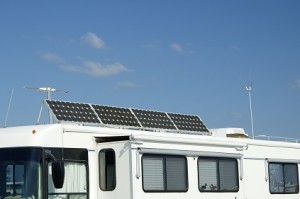RV solar panels: soaking up the sun's rays while on the move
Recreational Vehicles, or RVs, are gaining in popularity. It took sometime, but after the recession, consumers are enamored with this big-ticket item once again. Sales of RVs, both motorized and towable units, have increased considerably in the past year. A Bloomberg.com article reveals that, while sales of the less expensive towable versions are up 8.5%, sales of the more expensive motorized vehicles have jumped a whopping 30%. Moreover, in the US alone, more than 9 million households own one of these units. All of these RV owners must consider their options when it comes to powering their RV.
How many solar panels do you need on your RV?

Like cabins and cottages that are situated off the grid, RVs do not have a stable source of electricity. Most RVs and campers have traditionally relied on generators. But these are noisy and stinky and not conducive to a relaxing holiday touring your favorite destinations. More and more RV owners are coming around to the benefits of solar panels. Used alone or in combination with a generator, a so-called hybrid system, solar panels can meet most or ones needs. A small solar power system of about 80-130 watts (consisting of one or more panels, depending on their individual capacity) will easily power lights, a small television and some other light load requirements. If you want to power appliances requiring more energy, such as a vacuum, a microwave, or other bigger AC appliances, then you will need to consider your requirements carefully and install a system that will meet all of your needs: 200-400 watts of panels, or a smaller system in combination with a generator. Some people like the comfort and ease of mind that comes with a back-up generator for those moments when more electricity is required, or for cloudy days when your solar panel system is not generating as much electricity.
Do I need a battery as part of my solar panel system?
In addition to your solar panel requirements, you will also need to consider your battery requirements. This will be a function of the amount of electricity you plan on consuming and the amount of space you have. The less space you have available, the more you will have to ration your power consumption so that you don't run out of juice. You don't want to run your batteries dry, so it's important to build in a margin, about 50%, into your battery capacity. With batteries, it's fairly safe to say that you get what you pay for. You want to invest in quality deep-cycle batteries. That way, your system will work optimally and you shouldn't run out of power (another important consideration is that inactivity is very bad for a battery, so when you buy them, use them!). You will also need an inverter, and charge controllers. A typical small system of 100 watts should cost less than $1000 USD.
How do I know how much power I can generate in my next trip?
Curious about the solar energy potential of your next destination? Whether it's the Grand Canyon or Key West, WhatNextNow Solar Discover has the answer for you. Simply enter the location that you're interested in, and you can easily estimate how much power you can generate for any given month.
So get out there and start rolling! And if you feel like it, share with us and other readers what kind of system you installed for your RV. Does it meet your requirements? Would you do anything differently? People want to know!